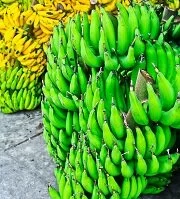Wildlife

Bananas
Despite being an island nation the number of native plants and animals in Papua New Guinea are shockingly large and some of the plants native to the island of New Guinea are now famous plants the world over. Despite the incredible native plant life, the native animal life isn't quite as impressive, although still larger than most island nations. Due to the close proximity to other islands and the Asian mainland, in addition to the waters and winds spreading plant seeds and animals, the country is very diverse today.
Despite the diversity, there are few native mammals on the islands. The native land mammals are limited to a few rodents and some bats. Despite this, many other mammals have been introduced to the islands thousands of years ago by people, including the platypus, opossums, rats, wild boars, dogs, and deer.
The other historic mammals present in, or around, Papua New Guinea live in the waters around the country, including dolphins and whales. These waters are also filled with thousands of fish, shellfish, and other forms of sea life. In these waters you can find surgeonfish, clownfish, puffer fish, butterfly fish, grouper, barracuda, tuna, mackerel, shrimp, krill, crab, seahorses, rays, sharks, jellyfish, starfish, and sea urchins among many others. On land, in the fresh water lakes and rivers there are hundreds more animals, including rainbow fish, gudgeons, gobies, grunters, glassfish, catfish, freshwater shrimp, crabs, and spiny lobsters, which are known as crayfish on the islands.

Sugarcane
Due to the overwhelming amount of water, land animals, and plants, it is not a surprise that the bird variety in Papua New Guinea is also substantially large. Pigeons, parrots, hornbills, eagles, and the hooded pitohui are just a few of the many birds that live on the islands or migrate through.
The reptilian and amphibious life is also fairly diverse, especially those animals that are adapt to living in the water. Frogs, toads, snakes, and lizards, including the monitor lizard are common on the lands. Numerous turtles are also common on both the land as well as in the sea as sea turtles call the surrounding waters home. The saltwater crocodile can also be found in the surrounding waters and in marshes.
Insects, spiders, and other small animals are also common in Papua New Guinea with hundreds of butterflies, flies, ants, bees, snails, and worms as well as various spiders that live in the country.
The native plant life in Papua New Guinea is, in a way, limited in scope as an island nation. However, the native plants to New Guinea are incredible in the impact they have made on the world from a culinary perspective. Coconuts, sugarcane, breadfruit, and taro are all believed to have originated on New Guinea. Additionally, bananas, yams, and lemons originated from the region as well (likely from Indonesia or Southeast Asia) and in early history these plants made their way to what is now known as Papua New Guinea.
There is also a substantial presence of other trees and plants, including hundreds of orchids, ferns, mosses, mangrove trees, and pandanus trees among many others.